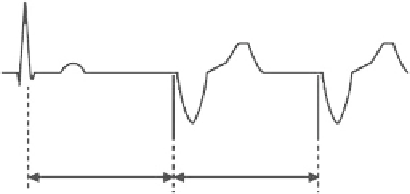Biomedical Engineering Reference
In-Depth Information
Vp
Vs
Vp
P
P
S
S
P
EI
LRI
Refractory period
Fig. 9.3
VVI inhibited mode timing
Fig. 9.1
Escape interval (EI) + lower rate interval (LRI)
P
P
S
P
S
P
S
P
P
P
P
P
Refractory period
Fig. 9.2
V00 asynchronous mode timing
Fig. 9.4
VVT triggered mode timing
9.1.1
Asynchronous Modes
pacing by, for example, noise. Pacing is delivered after the
lapse of the EI at the programmed LRL in the VVI mode or at
a rate indicated by a sensor in the VVI(R) mode. An event
sensed during a ventricular refractory period is classified as
refractory and does not inhibit ventricular pacing.
In AAI(R) modes, the timing is identical, but with an
atrial refractory period. The difference lies in the sensing
sensitivity, which must be higher for atrial sensing (i.e., a
lower value in millivolts).
Single-chamber asynchronous modes include A00 and V00.
They are the simplest pacing modes. The A00 mode provides
atrial pacing at a programmed LRL without inhibition by
sensed atrial events. The V00 mode provides ventricular pac-
ing at a programmed LRL without inhibition by sensed ven-
tricular events. Hence, sensing is not active in this mode, and
no further timing interval is defined. The timing is simple:
the counter runs according to the set LRL without the possi-
bility of resetting. After the counter stops, pacing is delivered
regardless of possible intrinsic cardiac activity.
The V00 asynchronous mode (Fig.
9.2
) was historically
the first pacing mode. Its main disadvantage (besides energy
consumption) is the danger of competitive pacing, that is, the
collision of a pacing pulse and intrinsic cardiac activity.
Pacing timing in a vulnerable phase (T wave) is capable of
inducing ventricular tachycardia.
9.1.3
Triggered Modes
In single-chamber triggered modes, including AAT and VVT
modes, sensed intrinsic cardiac activity triggers pacing and,
at the same time, resets the counter. These modes are rarely
used. In the VVT mode, pacing is delivered at the LRL. If an
intrinsic R wave is sensed before the lapse of EI, a pacing
pulse is applied immediately in the ventricle (Fig.
9.4
). The
pacing pulse will appear on the ECG somewhere during the
intrinsic QRS complex. Basically, AAT works on the same
principle - the difference is that it senses a P wave and paces
in the atrium. Upon the absence of intrinsic rhythm, the
modes are identical to VVI or V00. Naturally, the triggered
modes may sense even external interference as intrinsic car-
diac activity.
The VVT mode may be used for diagnostic purposes. The
upper pacing rate (also upper rate or maximum pacing rate
[MPR]) is limited by the refractory period and runaway pro-
tection [ 94 ] .
9.1.2
Inhibited Modes
During inhibited modes (AAI and VVI), sensed intrinsic car-
diac activity resets the counter and retriggers the EI. In inhib-
ited modes, the LRL is supplemented with additional time
intervals. It is a blanking period of the sensing channel and a
refractory period (Fig.
9.3
), described further in greater detail
in Sect. 9.4. In the VVI mode, the ventricle is paced in case no
intrinsic ventricular events are sensed; the setting of the ven-
tricular refractory period avoids the inhibition of ventricular





























































